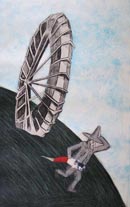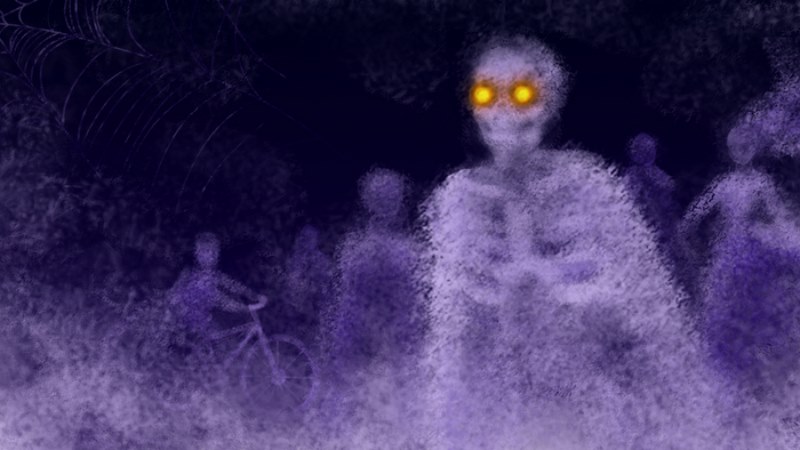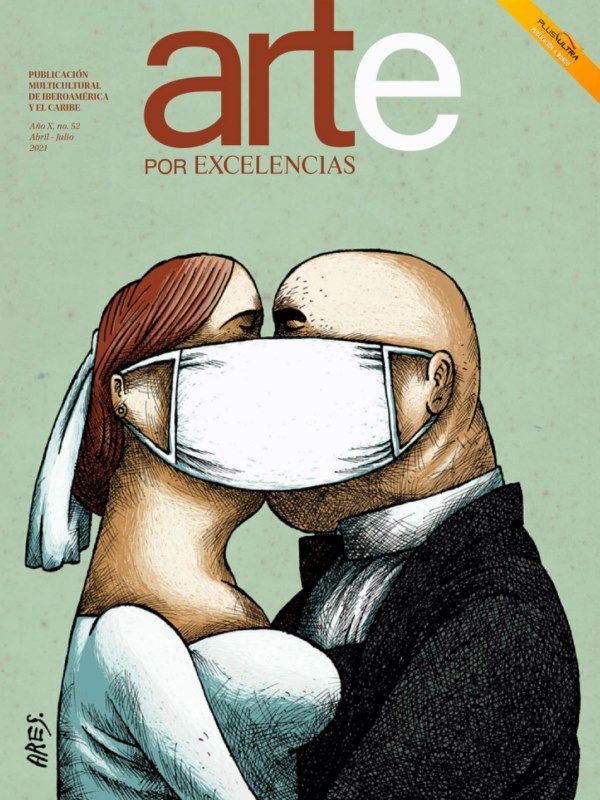When someone has the privilege of seeing as a sequence the work of Sandra Ramos, on a disk with neat images, you get the impression of having entered with Alice in her journey through the unreal wonderland. Sandra is always present there, just like that “curious creature [...] given to clearly pretending her endeavor, believing to be two instead of one”.
But her work, unlike what is established, is not autobiographical (it was so only in four of her early engravings). Though her face appears all the time, it becomes a sort of alter ego, which leads us through her inspiring universe full of suggestions.
Sandra is a jaunty and cheerful woman. However, to my perception, her discourse paradoxically reveals an atmosphere where nostalgia, gloominess and sadness join in. The tone, polite indeed, denotes confusion and bewilderment at the world, but still strong, sharp and ironic at times, even sarcastic. She works hard, in a cathartic and exorcism compass. When questioned about these remarks, she answered quickly and from laughter, “That is why I never get depressed!”
It is far from being questioned the work of this artist, who manages herself adroitly and effectively in the engraving art, in painting (in acrylic better than in oil), in drawing, installations, digital printing and video. Much of what she does appeals attractive for both, those with a sophisticated eye and those unacquainted with the artistic codes as well. When arguing on the aesthetic issue and how to control the “cuteness” that flows naturally from her work, she mentioned her constant struggle for finding the right balance. Since the artistic form agrees the message, some works turn out to be more narratives for her while others are more symbolic. Sandra enjoys everything she does; though she expressed to feel better off when working with installations: “they are something different, like when you break your everyday life routine”.
Against all established stereotypes –those who make her known for her mastery of engraving and for treating the emigration issue– her focus of interest is that of the limit. Hence, the appearance in her work of such cloistered figures, borders, frames, confining peripheral lines, etc. “There is no total freedom”, she told me. “Total freedom is not possible for anything or anyone, because everything is limited by something. Total freedom would be not to exist”. Maybe that is the reason for the ubiquity of water in her creations, if not physically, by the use of metallic paper in allusion to the liquid, rich in symbolism. Sandra’s work is highly permeated by a symbolic language, though sometimes there is too much of literalism on it.
Freedom and water are recurrent in her work as a leitmotiv. The first one, understood from the philosophical point of view like the absence of conditions and limits, as self-chance and self-determination are concerned. The second one is given by the duality of the symbol, on the track of Zoroaster’s doctrine, which supports two principles or divinities, those of good and evil that constantly fight among themselves and are metaphorized by Sandra through drowning, shipwrecks, and revitalizing cleanings, etc.
There are plenty of symbols for water. In Jewish folklore, for example, the separation of the waters made by God into upper and lower ones designates the water division into male and female categories, symbolizing security and insecurity, male and female. Water can be considered in two opposite planes, but by no means irreducible. Such ambivalence is at all levels. Water is a source of life and death, creative and destructive. It is even a symbol of spiritual life. A similar ambivalence is seen in Sandra, in the same subtle way that spirituality emanates from many of her creations.
History is also a fairly common issue in Sandra’s artistic work. Likewise, she assumes familiar cartoon and humorous Cuban drawing characters, like Abela the fool, Liborio, etc., and places them into a dialogue with representations of characters of her own invention to establish the recurrence of situations. The comments those Creole prototypes made of their epoch are still valid for her. She aims to find the background of current events, since she holds the criterion that nothing happens by chance; everything has a reference in the country’s history.
It is not by chance that Sandra’s work is rich in meanings and connotations that contribute to the title of the pieces. It is thanks to her rich inner world, nurtured by multiple readings that include literature (poetry, mostly), classical philosophy, history, etc. Therefore, it is relatively easy for her to resort to improved quotations or to use old engravings, recontextualized when commenting on today’s issues with them. With such images she achieves a sort of unreal visuality, but yet with a work regardless of surrealism. At least, they give the impression of unreal worlds that bring to our minds Alice’s favorite phrase to begin her stories: “Let’s imagine that...” And then comes the viewer’s possibility of telling stories... Limits in this case, lay in his capacity for invention.




Publicación anterior LET’S COME CLOSER TO A (SO-CALLED) HAVANA HOUSE
Publicación siguiente Contemporary Dominican Sculpture
Publicaciones relacionadas

Obras de García Márquez para celebrar Halloween
Octubre 30, 2024
Cerrado por obras: Museo Sorolla
Octubre 29, 2024
La Mascarada llena de color y vida a Costa Rica
Octubre 28, 2024












